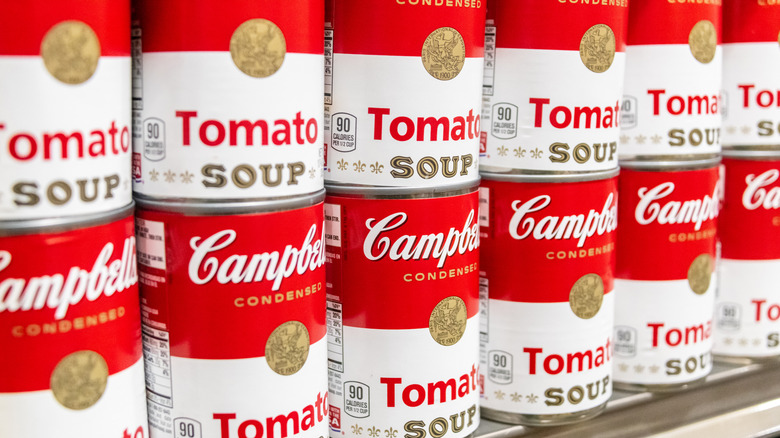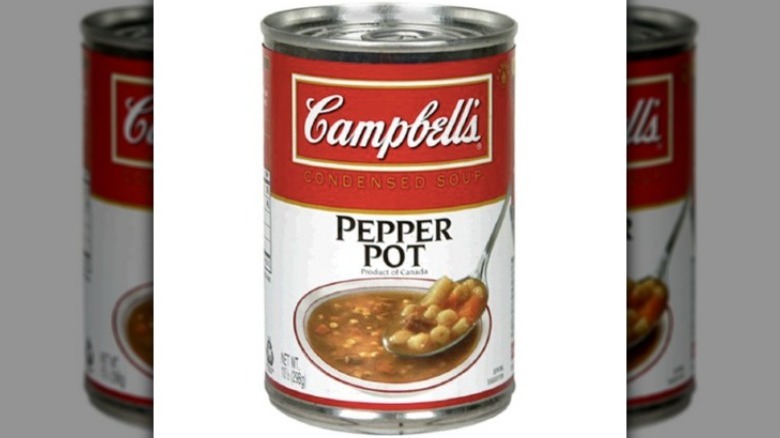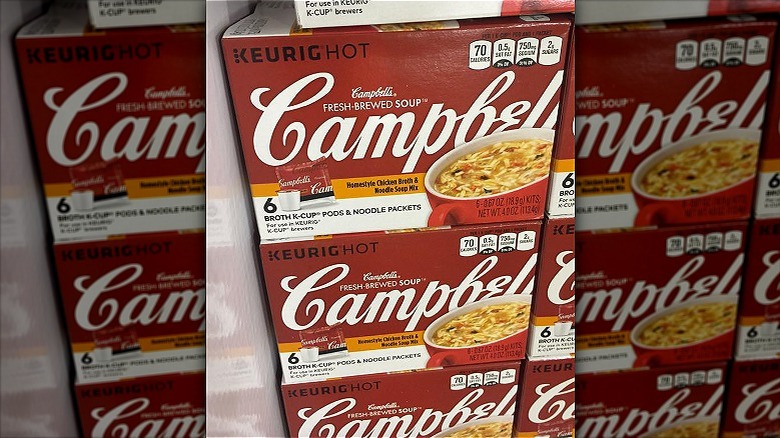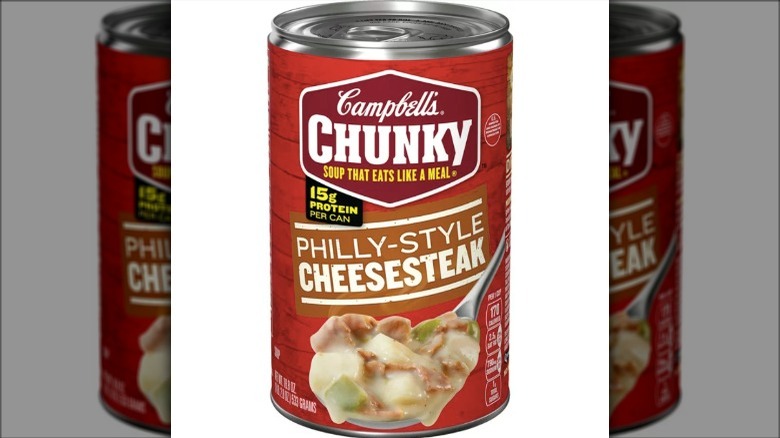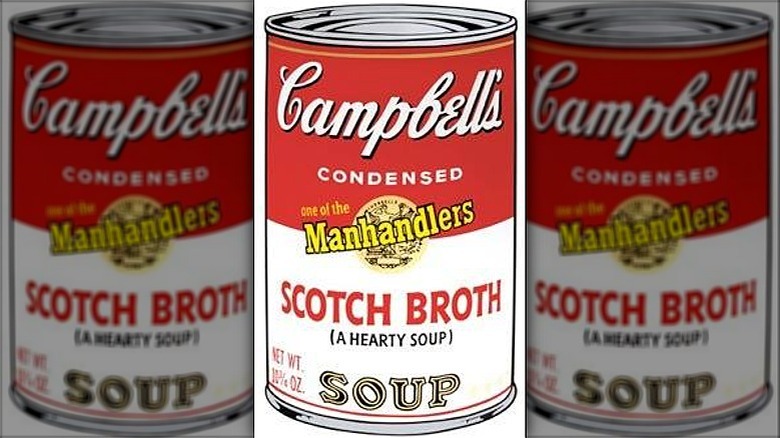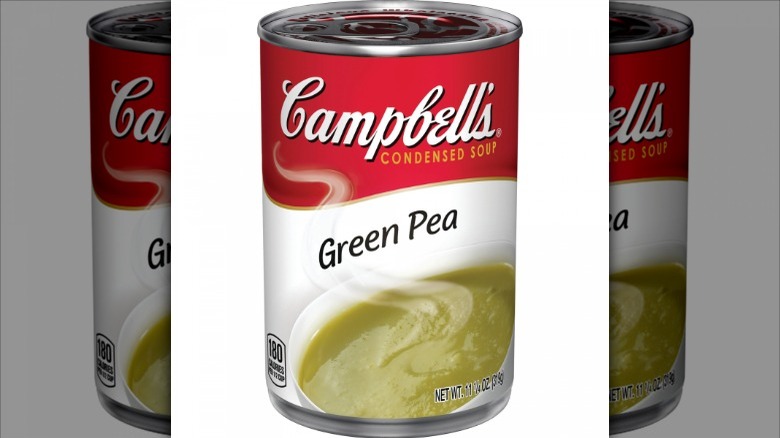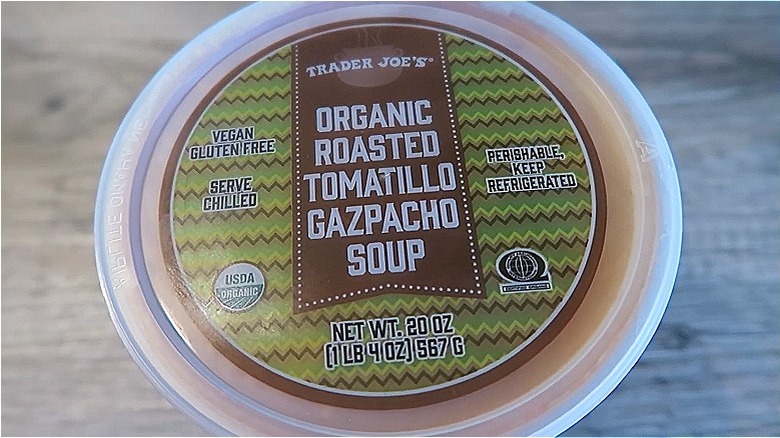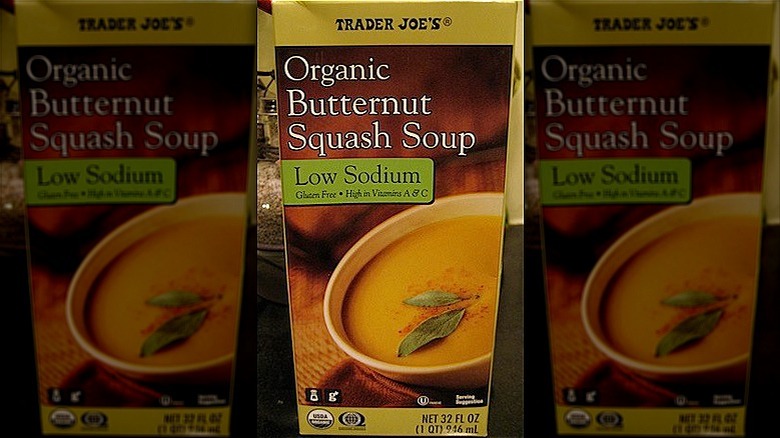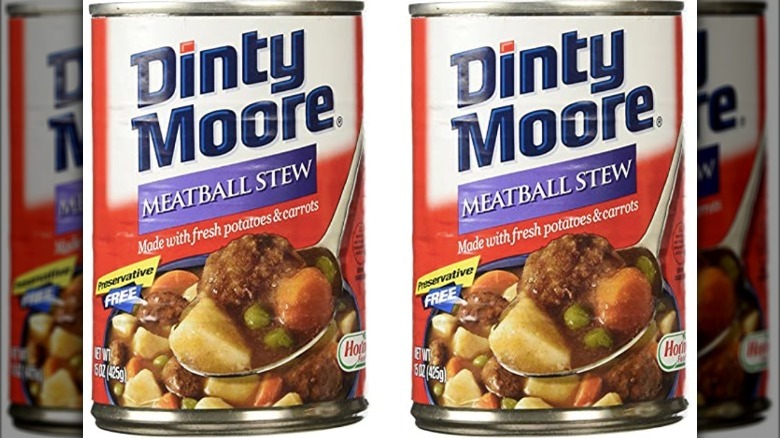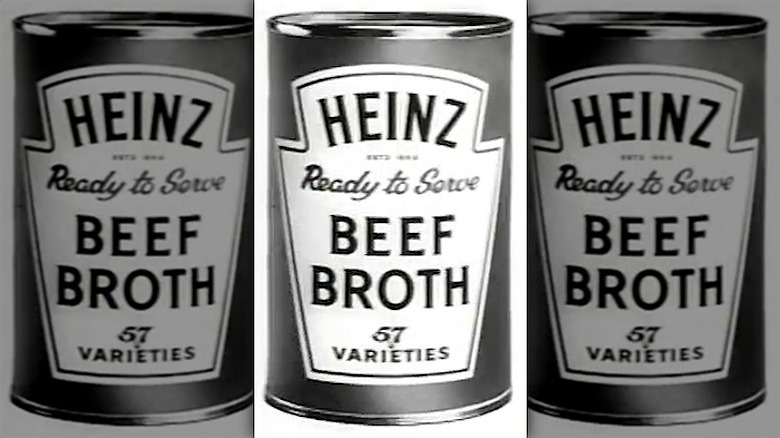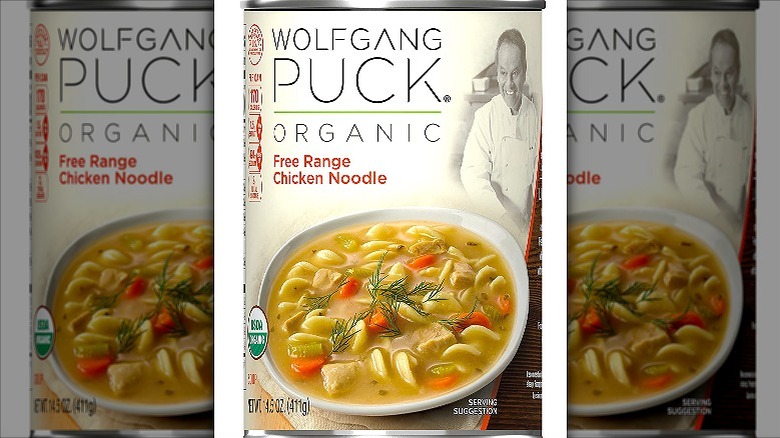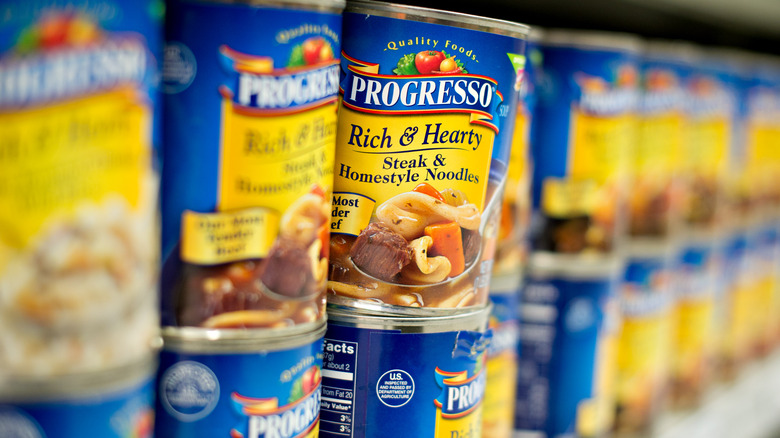12 Discontinued Store-Bought Soups We Aren't Getting Back
We may receive a commission on purchases made from links.
Although the process of canning food to preserve it can be attributed to 19th century France, it has become big business in 21st century America. The top canned food item purchased in the U.S. is canned soup, although soup is also available in cartons and frozen packaging.
There is no doubt that store-bought soup has a lot going for it. It is quick, easy, and affordable. Soup is one of those foods that come pre-programmed with certain cultural connotations. The title "Chicken Soup for the Soul" got its name because it was the perfect metaphor for something that would elicit nostalgia for when your grandma came to the rescue with a comforting and soothing bowl of hot chicken noodle soup to help combat the cold you were ailing from.
The point is that store-bought soup fills more than just our bellies. It feeds a hunger in our hearts and souls without all the intense labor required to produce a big batch of homemade soup. This fact is not something to scoff at. And once we find our favorite flavor of store-bought soup, we keep it on hand to rescue us in a pinch.
But what happens when that flavor you have come to rely upon disappears? It leaves our tummies and hearts empty, void of sustenance, which is at stake when a brand discontinues a soup. Let's look at some of these store-bought soups that we aren't getting back, that broke our hearts and left us wondering what could fill that warm, delicious void in our lives.
1. Campbell's Pepper Pot Soup
Pepper pot soup is a soup that originated in West Africa and the Caribbean and eventually made its way to North America as part of the slave trade, where it became hugely popular. Legend has it that this delicacy was fed to the Continental Army at Valley Forge in 1777 during the Revolutionary War to help boost morale and provide much-needed sustenance during an endless winter. It has been called the soup that won the war.
The soup itself is almost like a stew, owing its name to the fact that it historically got made with copious quantities of whole black pepper, but the star of the show is tripe, which is the lining of the stomach of a cow. The tripe gets combined with vegetables and spices and simmered for hours until the tripe becomes silky and has absorbed the flavors of the broth. Campbell's Soup Company knew a good thing when it saw it and began offering a canned version of this dish in 1889.
Its version was unique thanks to the jacked-up heat conferred by adding jalapenos and red pepper flakes. The soup, which warmed people's nasal passages and tummies, was a staple of the Campbell's collection until 2010 when it got discontinued, presumably because the idea of eating offal has become less popular in the U.S. That said, folks still lament the loss of this soup, making copycat recipes for the spicy delight quite rampant across the internet.
2. Campbell's K-Cup single serve soups
When Keurig and Campbell's Soup Company joined forces in 2013 to develop a line of snack-size soups that could be heated using Keurig brewers, the idea was initially met with enormous enthusiasm. In 2013, Keurig experienced a 16% spike in revenue, with an 18% jump in K-Cups sold. The creative juices at Campbell's conceived of the idea that if it could put a powdered broth of dried vegetables and noodles into a K-Cup that could be brewed for a quick and healthy snack using a Keurig brewer, this would be a huge seller. Sadly, it was not.
Part of the issue was the time that passed between the announcement of the launch and the launch itself, which didn't occur until 2015, a full two years later. By this point, environmental concerns over single-use K-Cups had become an issue, and by 2015 Keurig had sustained a 13% drop in net sales, with a 9% decline in K-Cup revenue. Sustainability concerns aside, there were other reasons the soups didn't sell.
Consumers found them less filling than a regular can of Campbell's soup, more expensive, and out of place in both the soup aisle and the coffee aisle of the grocery store. But most of all, customers felt weird about making soup in their coffee makers. There was a built-in yuck factor that most couldn't get past, which led to the products getting yanked in the spring of 2016.
3. Campbell's Chunky Philly-Style Cheesesteak Soup
Campbell's Chunky soup line was developed as an alternative that would provide a more hearty, stick-to-your-ribs option with bold flavors. Its slogans for this line include It Fills You Up Right and Soup That Eats Like a Meal, indicating the need for soup options that were more substantial than its original lines of canned soup.
The Philly-style cheesesteak flavor was chock full of starchy potatoes, beef, onions, peppers, and copious quantities of cheese and franken-cheeses. A single can would boast a heart-stopping 1,720 milligrams of sodium, almost as much as the recommended daily allowance for sodium as established by the U.S. Food and Drug Administration.
Customer reviews weren't exactly enthusiastic. While some enjoyed it, most quickly pointed out that it tasted nothing like an authentic Philly cheesesteak. Others commented on the disproportionate amount of potatoes in the mix, which as the first ingredient on the list, overpowered everything else. And still, others noted that the beef, what little of it was there, was chewy and fibrous. Not exactly satiating. Ultimately this soup was discontinued, making way for less watery, more satisfying flavors to take its place.
4. Campbell's Scotch Broth Soup
As its name suggests, the Scotch Broth is a stew-like soup with origins that date back to 18th century Scotland. It was a soup made from beef or mutton, barley, split peas, onions, herbs, and hearty root vegetables. Campbell's canned variation contained lamb, barley, and a limited variety of vegetables steeped in broth to create a slightly less unctuous sample of this classic. While this soup was well-liked, as Campbell notes on its website, it constantly monitors changes in consumer preferences, and as sales for a particular brand dwindle, they adapt accordingly. Sales for Scotch Broth did begin to diminish, and eventually, the Scotch Broth flavor got discontinued.
Fans of this soup need not worry, as a much more flavorful variety of this classic can be reproduced at home and frozen in individual portions for quick and easy reheating. If cooking is not a hobby you enjoy, you can obtain a bit of Scotch Broth nostalgia. For just a few hundred dollars, you can buy a limited edition Andy Warhol lithograph from 1986 called Campbell's Scotch Broth Soup. The lithograph is hand numbered and stamped with the Carnegie Museum of Art official CMOA on the backside. But act fast — only 3,000 of these got put into circulation.
5. Campbell's Green Pea soup
Pea soup was a staple of Greek and Roman civilizations as long ago as 500 to 400 B.C. It came to the U.S. in the 19th century with French-Canadian millworkers, who presumably brought their famed Habitant soup recipe to fuel them and give them a taste of home. Perhaps not surprisingly, a variety of this hearty and healthy staple got adopted by Campbell's Soup Company. Its canned variety left much to the imagination, containing little more than water, split peas, sugar, flour, butter, and scant celery and onion extracts.
Despite its meager ingredients, reviews for the soup were relatively favorable, with some noting they liked it because, unlike other pea soups, this one did not contain ham. Ironically, Green Pea soup subsequently got replaced with Condensed Split Pea, Ham & Bacon Soup, which some reviewers have noted liking less than the discontinued flavor.
According to its website, Campbell's recommends those who enjoyed the discontinued Green Pea Soup try its Habitant French-Canadian Pea Soup as a substitute, which contains nothing more than water, yellow peas, lard, modified corn starch, salt, onion powder, and spices.
Like Campbell's Scotch Broth soup, its Green Pea soup got commemorated by Andy Warhol in a series of silkscreen prints on paper titled "Soup Can 11.50 (Green Pea)," which also sells for a pretty penny. There was clearly a unique relationship between Campbell's Soups and Andy Warhol.
6. Trader Joe's Gazpacho
Trader Joe's has a distinctly loyal fan base, more so than practically any grocery store chain. Indeed, we love its unique business model and one-of-a-kind selection of prepared and frozen foods, and who could pass up on a tasty bottle of Two Buck Chuck? When a product gets discontinued from Trader Joe's, it results in many disgruntled customers, which is what happened when its Gazpacho soup disappeared somewhere around 2018 and 2019.
The creamy play on the Andalusian classic chilled soup made of fresh summer vegetables, soaked day-old bread, garlic, and olive oil was the perfect lunch on a hot day. This gazpacho got replaced with a new variation of a Roasted Tomatillo Gazpacho, which was not quite as popular. Customers were so disappointed in the updated flavor that it also got discontinued, leaving Trader Joe's gazpacho-less.
In true Trader Joe's style, it offers a Discontinued Product Feedback form on its website, where loyalists can express their discontent, or rather, devastation, in written format. It notes that this is a one-way form that will not receive any response. We suppose it is a helpful therapeutic exercise for those mourning their favorite long-lost products to be able to get their grief off their chests. In the meantime, Trader Joe's has one less soup on its roster of offerings.
7. Trader Joe's Butternut Squash Soup
Another Trader Joe's related soup discontinuation incident is its beloved Organic Butternut Squash Soup. This soup is one of its most enduring offerings, which has satisfied customers until it appeared on its endangered list in the fall of 2022. Reviewers note its rich, creamy texture and butternut squash-forward flavor, which is the perfect comfort food for a cold winter day. Comments echo these sentiments inquiring why Trader Joe's would do away with one of its most popular items.
It may not seem to make much sense, but presumably, Trader Joe's has some reason. Perhaps it is trying to reserve its Butternut Squash flavored items, like the beloved Butternut Squash Mac & Cheese, as a seasonal specialty. For now, consumers will have to settle for one of its remaining soup options, which include Italian-Style Wedding Soup, Organic Lentil Vegetable Soup, Kettle Cooked Chicken Soup, Organic Split Pea Soup, Kimchi & Tofu Soup, Organic Tomato & Roasted Red Pepper Soup, Tomato Feta Soup, Unexpected Cheddar Broccoli Soup, Organic Hearty Minestrone Soup, Garden Vegetable Soup, and Beef Pho.
8. Dinty Moore Meatball Stew
Perhaps a stew does not belong on a list of discontinued soups, but when you peruse the aisles of a grocery store, cans of soup and stew are generally sold in the same section. And let us be honest, many of the chunky soup options for sale today are more stew-like than they are soup-like anyway, so these terms might as well get utilized interchangeably.
Among the most enduring stew brands is Dinty Moore, which has been selling its famed beef stew since the 1930s. Though the brand has attempted to introduce a number of different flavors in the course of its many years in operation, like its Meatball Stew, none have survived except its traditional beef stew and chicken and dumplings.
Reviews may be a good indicator as to why this flavor got axed. The meatballs have been described on Amazon as "hot dog like" and "small and flat like shaped." Not exactly the most glowing feedback. Sometimes it pays to stick to what works and not change things up. That's where Dinty Moore has landed. If it ain't broke, don't fix it.
9. Heinz Beef Soup
Few soups have the kind of popularity to warrant a Facebook page dedicated to it. Heinz Beef Soup holds this distinction with the Bring back Heinz Beef Soup! page, which is over 600 members strong. These fans aren't backing down either, but have engaged in quite the campaign of writing letters, social media posts, and otherwise attempting to attract the attention of Heinz to bring back their discontinued Beef Soup flavor. The irony is that they still offer a Beef Stock flavor, Steak & Onion, Steak & Potato, and Beef & Vegetable, so it isn't a matter of some sinister anti-beef vegan-friendly stance, something suggested by Discontinued News.
Heinz entered the market in 1869, selling bottled grated horseradish. It introduced its first soup, a Cream of Tomato Soup, in 1910. It has continued producing quality products focusing on sustainability over the past 150 years. And while not necessarily linked with the disappearance of its Beef Soup, Heinz did develop a product line called Plant Proteinz Soups, specifically aimed to target vegans, vegetarians, and flexitarians, showing its capacity to adapt to market demand.
10. Wolfgang Puck Organic Chicken Noodle Soup
In 2008, Campbell's Soup Company announced acquiring and licensing rights to the Wolfgang Puck brand to increase its profile of healthier and higher-end options within North America. Campbell's wanted to offer the Wolfgang Puck brand under its corporate umbrella. However, as of the publication of this article, no Wolfgang Puck brand items appear listed on Campbell's website, nor are they showing as in stock at retailers, confirming the discontinuation of its Organic Free Range Chicken Noodle Soup.
Recent reviews are few and far between, with several noting they received only partial orders with dented cans, presumably older cans of soup that remained in stock. That said, earlier reviews from around the time Campbell's acquired the soup brand were favorable, with many commenting on the rich flavor of the broth, which tasted homemade, and others mentioned they appreciated the organic, natural ingredients, particularly for consumers with food allergies. It would appear that even the name of a celebrity chef on your product isn't a guarantee that it will sell.
11. Progresso Creamy Potato Soup
In July 2020, executives from General Mills, owner of the Progresso soup brand, announced the discontinuation of approximately 40 of its 90 soup flavors from store shelves in response to the Covid-19 pandemic. Contrary to popular belief, the issue prompting the decision had nothing to do with waning sales.
Sales increased dramatically during the early months of the pandemic as consumers sought more options to fill their pantries. The issue at hand was the limited ability of retailers to keep store shelves stocked. General Mills decided to streamline its offerings to accommodate retailers' needs. One of the beloved flavors eliminated during this time was the Creamy Potato Soup.
As the pandemic continued in 2021, Progresso re-evaluated this decision, slowly reintroducing many of the axed flavors to help accommodate more people working remotely from home. It has since added new flavors, like Italian Sausage & Potato, Spicy New England Clam Chowder, and Spicy Tomato. Unfortunately, Creamy Potato never found its way back into the mix.
12. Trader Joe's Cioppino Seafood Stew
A classic cioppino is a thing of beauty. This fish stew originated in San Francisco in the 1850s when Italian fishermen repurposed unsold fish from their daily catch by cooking them with wine, garlic, onions, tomatoes, and herbs. The resulting stew became so popular that it found its way onto restaurant menus from California to New York. Not unsurprisingly, a frozen variation of this dish made its way into Trader Joe's. The stew quickly became a fan favorite, thanks to its affordability — $6 for 1 pound of seafood is a steal.
Sadly, in 2022 Trader Joe's announced it was discontinuing the beloved Cioppino Seafood Stew, prompting fans to take to social media. Fans on a popular Instagram page that highlights discontinued Trader Joe's items were not happy. Meanwhile, commenters on the Trader Joe's Reviews website voiced their frustration, "What's going on, TJ? why are so many great products disappearing and not returning to your shelves? From an extremely concerned TJ shopper." Thus far, their pleas have gone unheard, but perhaps Trader Joe's will get the message and return their Cioppino Seafood Stew soon.
